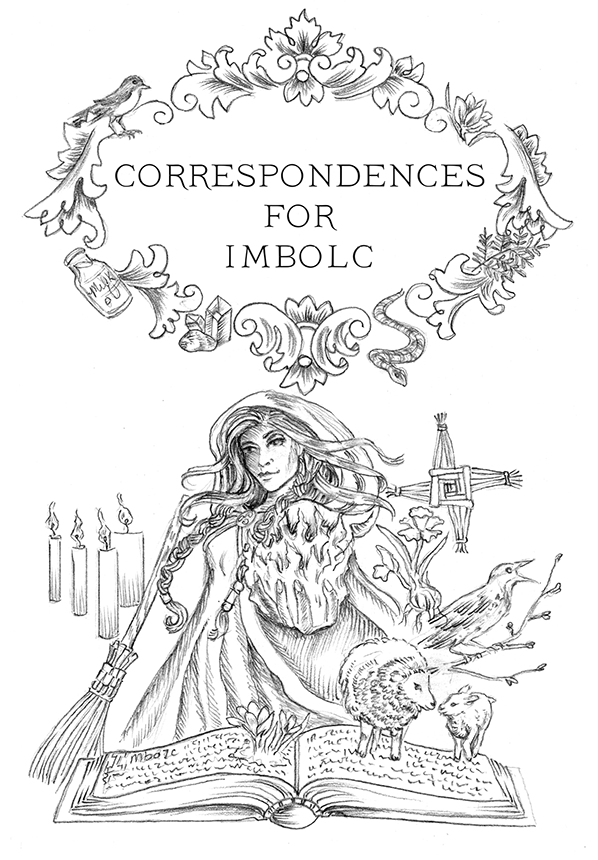
Spiritual Focus and Key Words
Beginnings
preparation
patience
awakening
thrift
newness/renewal
“child-like delight in all things” (Starhawk)
innocence
change
emergence from sleep/hibernation
cleansing
sprouting seeds
fertility
transitions
Magical Focus and Suggested Workings
Cleansing
protection
divination
birth/rebirth
transformation
youth
well-being
emergence
awakenings
Astrological Timing and Associated Planets
Astronomical midpoint between the winter solstice and the vernal equinox; Sun at 15° of Aquarius in Northern Hemisphere, Sun at 15° of Leo in Southern Hemisphere. Some Pagans celebrate Imbolc on the astronomical date; others stick to February 2 out of tradition.
Archetypes
Female
The Goddess transforming from Crone to Maiden
the Goddess in the form of young mother tending to her growing child
Male
God in the form of a child exploring the world
the innocence of the masculine
Deities and Heroes
Goddesses
Brigid (Irish)
Aphrodite/Venus (Greco-Roman)
Diana (Etruscan/Roman)
Arianrhod (Welsh)
Artio (Swiss)
Athena (Greek)
Danu (Irish)
Gaia (Greek)
Inanna (Hausa/West Africa)
Juno (Roman)
Selene (Greek)
Vesta (Roman)
Selu (Cherokee)
Gods
Februus (Roman)
Bragi (Norse)
Cupid (Roman)
Dian Cecht (Irish)
Dumuzi (Sumarian)
Eros (Greek)
Colors
Light Green: Abundance, growth, fertility, health, calming, new beginnings, prosperity
Pink: Harmony, tenderness, affection, love, spiritual healing, virtue, spring, honor, contentment
White: Cleansing, peace, protection, healing, truth, divination, purification, childhood, innocence
Yellow: Joy, vitality, creativity, communication, the sun, planning, psychic ability, attraction
Herbs
Angelica: Balance, new beginnings, consecration, insight, purification, stability, success
Basil: Clarity, divination, love, money, protection, strength, success
Blackberry/Bramble: Growth, attachments, fertility, intuition, prosperity, protection, purification
Cinnamon: Balance, blessings, courage, protection, purification, strength, success
Grain: Protection, abundance, fertility, community, balance, birth/rebirth, blessing
Reed: Action, awareness, confidence, growth, healing, inspiration, protection, unity
Wormwood: Banishing, divination/dream work, forgiveness, overcoming obstacles, purification
Trees
Blackthorn: Banishing, guidance, obstacles, protection, strength, magick
Cedar: Affection, balance, calm, clarity, community, blessing, growth, fertility, peace, purification, success
Rowan: Authority, blessings, challenges, devotion, divination, enchantment, fertility, forgiveness, inspiration
Sycamore: Abundance, communication, determination, harmony, learning, love, obstacles, protection, stability, wisdom
Flowers
Crocus: Attract love, visions, sobriety, and rebirth
Daffodil: Calm, fairies, fertility, love, perseverance, magick, wishing
Crystals and Stones
Amethyst: Dreams, healing, courage, happiness, balance, beginnings, change, divination, growth, rebirth, transformation
Turquoise: Attraction, balance, clarity, compassion, courage, healing, improvement, inner strength, wisdom
Metals
Antimony: Protection, shielding, energy, and strength
Brass: Balance, reversal, security, and solar energies
Gold: Authority, power, success, wisdom, light/illumination, purification, strength, success
Animals, Totems, and Mythical Creatures
Cow: Abundance, comfort, nourishment, pregnancy/childbirth, love, home, and warmth; the cow is one of the symbols of the goddess Brigid.
Dragon: Balance, challenges, courage, creativity, dignity, enlightenment, guardian, wisdom, and power; the dragon is closely tied to this time of year and to the goddess Bridgid.
Groundhog: Beginnings, community, cycles, family, rebirth, divination, earth energies; if the groundhog sees its shadow on Imbolc it means that spring will come late.
Lark: A lark singing on Imbolc means an early spring
Robin: Change, growth, omens, wishes; the robin is often the first sign of spring. Shows the end of the cold winter and announces the coming of the sun and warmer days.
Sheep: Abundance, balance, beginnings, nurturing, security, support; “Imbolc” refers to the first lactation of sheep; an early sign spring is coming.
Snake: Change, cunning, cycles, rebirth, wisdom, enchantment; as the snake is reborn after shedding skin, the snake represents changes and new beginnings. The snake is also closely associated with the goddess Brigid.
Swan: Awakening, beauty, grace, innocence, sleep, transformation, trust. The swan has long been a symbol of change and transformation, even representing the transition between life and death.
Scents for Oils, Incense, Potpourri, or Just Floating in the Air
Cedar
peppermint
styrax
basil
cinnamon
Tarot Keys
Death
the Empress
the Star
Symbols and Tools
Brid’s Cross/Brighid’s Cross
corn dollies
Brid’s bed
candles
Saint Brighid
Saint Mary
the cauldron
broom/besom
whistle
Foods
Dried fruits
grains
potatoes
cornmeal
dried/salted meats
cheese
pickled or canned foods
nuts
eggs
Drinks
All dairy products
ale
mead
cider
Activities and Traditions of Practice
Making a corn dolly or Brigid’s Cross
candle making and/or blessing
making fortune cookies
dedicate new magickal tools
blessing of animals
blessing of new projects
divination
fireworks
Acts of Service
Clear snow/ice from public walkways
gather blankets for the needy
clear and prepare a community garden or flower bed for planting; clean the home of a physically limited person
Alternate Names for Imbolc in other Pagan Traditions
Imbolc or Imbolg (Gaelic, “in the belly,” referring to the ewes’ first milk of the year)
Oimelc (Saxon, “ewe’s milk”)
Feast of Brighid
Lá Fhéile Bríde (Irish)
Laa’l Breeshey (Manx)
Feast of Mary of the Candles (Welsh)
Holidays or Traditions Occurring During
Imbolc in the Northern Hemisphere
Religious
Feast Day of Saint Brigit of Kildare (Catholic, February 1)
Presentation of Jesus at the Temple or Candlemas (Christian, February 2, also called “Feast of the Purification of the Virgin,” and “the Meeting of the Lord”)
The Feast of St. Valentine (February 14)
Lupercalia/Pan’s Day (February 15)
Milk/Nursing Moon (varies but usually during Imbolc)
Pre-Lenten festivals and start of Lent (Catholic, moveable dates; between February 4 and March 10)
Parinirvana/Nirvana Day (Mahayana Buddhist, February 8 or Feb. 15)
Secular
Groundhog Day (February 2)
Valentine’s Day (February 14)
Chinese New Year (varies)
Mardi Gras (varies)
Holidays or Traditions Occurring During
Imbolc in the Southern Hemisphere
Religious
Festival of the Dryads (Grecian, August 1–3)
Nemoralia (Roman, August 13–15)
Tisha B’Av (Jewish, July or August, variable dates according to the lunar calendar)
Assumption Day (Christian, August 15)
Secular
Picnic Day (Autralia’s Northern
Territory, first Monday of August)
National Women’s Day (South Africa, August 9)
Various independence days in South America: July 9, Argentina; July 28, Peru; August 6, Bolivia; August 10, Ecuador; Aug. 25: Uruguay; July 24,
Birth of Simon Bolivar, liberator of Venezuela, Colombia, Ecuador, Peru, and Bolivia,
Heroes’ Day (various African countries, July/August)
Farmers’ Day (various African countries, July/August)